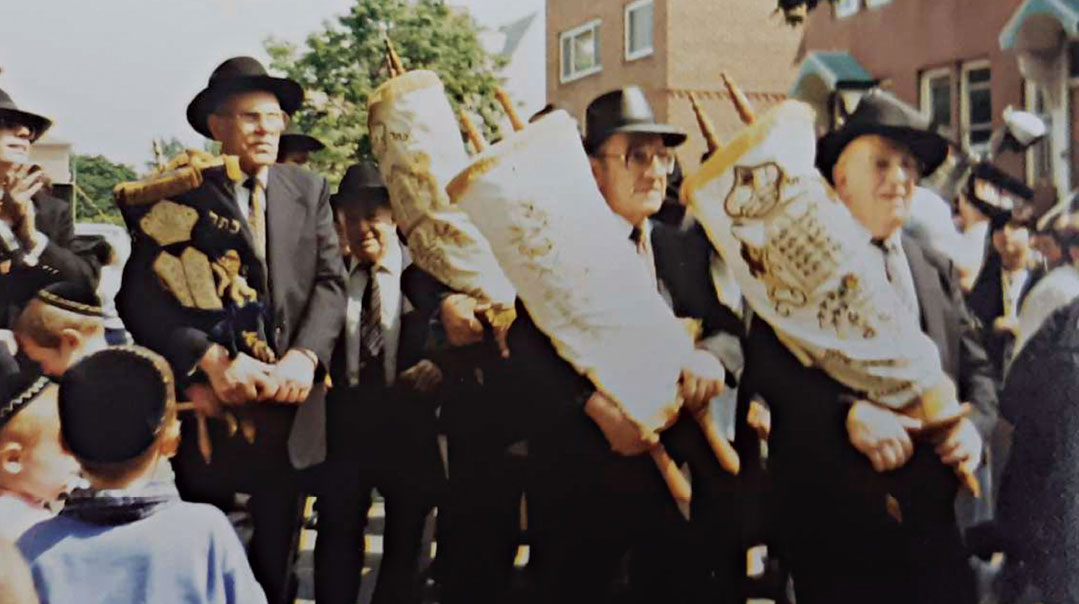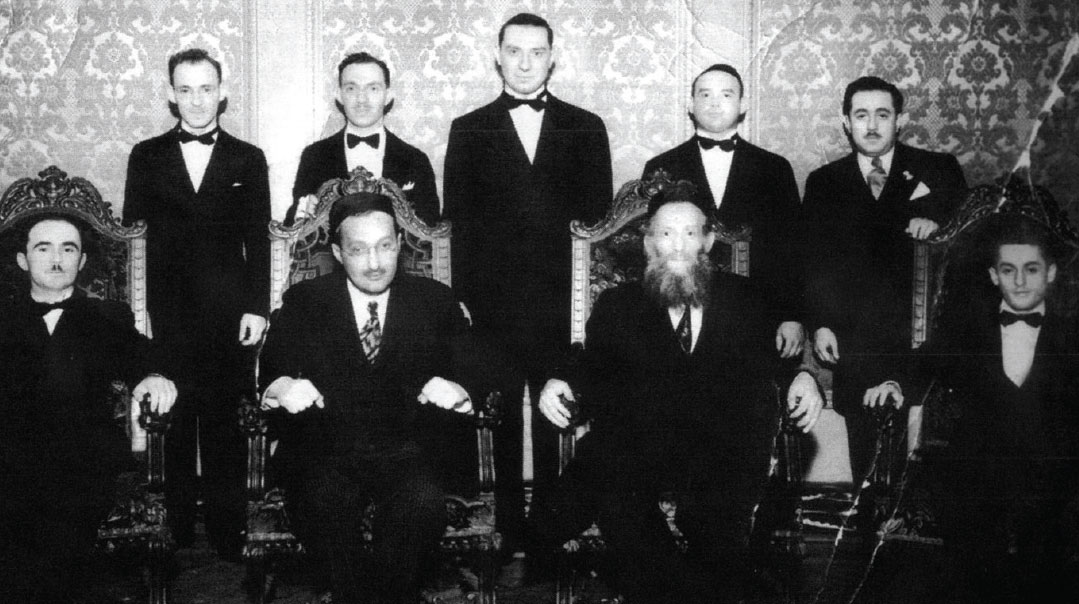The Apartment Above the Shtibel

Now, in hindsight, I wonder about it. A shul that had a rebbetzin, and no official rav? But back then it seemed natural

On top of a Boro Park shtibel, my great-grandmother welcomed endless circles of family, friends, and loyal mispallelim. Somehow this tiny woman, staunchly faithful to the heritage of Galicia’s chassidic courts, intuited the sensitivities and proclivities of a new generation, offering warmth and acceptance with wit, wise advice, and her famous kugel. What was her secret?
I didn’t live in Boro Park, but I always felt a little spark of ownership when I passed by a brick building on a corner of 16th Avenue. It was a shul known as the Bertcher shtibel, and it was our family’s shul. To be more exact, it was my great-grandmother, Rebbetzin Chaya Hinda Rokeach’s shul. She was the Bertcher Rebbetzin, the presence and the pillar holding up a shul that had lost its rav decades before.
Now, in hindsight, I wonder about it. A shul that had a rebbetzin, and no official rav? But back then it seemed natural. After her husband was felled by a heart attack, an able gabbai and her sons and sons-in-law, particularly my grandfather, helped run the shul. She supplied the kiddush every week — trays of sponge and marble cake, and a famous, uniquely American cornflakes kugel. The mispallelim loved the shul, and loved davening together. And so the minyan kept running.
What kind of presence must she have had, what kind of respect and loyalty must she have won, to keep that shul going for so many years?
I wonder about other things too. My diminutive great-grandmother — at less than five feet, we called her “Little Babi” to differentiate her from our grandmother — was the picture of a rebbetzin from the alte heim. She covered her head with a “kupka” — something like a shtern tichel, with some fabric representing hair attached — and wore only four colors, all as conservative and quiet as could be: black, navy, brown, and gray. She greeted Shabbos with a white kerchief and white lace apron. She davened devotedly. In short, she was the archetypical chassidishe rebbetzin.
Yet there was something remarkably broad about her outlook. I knew she was smart, so it seemed normal to me that she could quote Tanach, that she could write letters in Ivrit to the Israeli grandchildren, or that she avidly followed world news. It took years for me to realize how unusual that was for a woman who had never been formally schooled, and who had grown up in an insulated, ideologically zealous home.
More than that, she accepted, even celebrated, her American grandchildren and their accomplishments. She gave each child and grandchild space and affirmation to find their path in this new country where all the rules were different and chassidus seemed like a dying relic.
What would happen if I could revisit all those memories and recalibrate my perceptions from a more adult perspective?

I reached out to some of the people who knew her well, probing them for their memories and individual takes. As I listened and took notes, I realized this was a futile quest. So many people were touched and affected by this woman — and each one saw Little Babi’s persona through their own disparate filter, told a narrative that highlighted their own values. The cousins who take pride in their chassidic lifestyle saw her fealty for tradition. The cousins who value higher learning talked of her thirst for knowledge. The cousins who settled in Eretz Yisrael spoke of her love and concern for the Holy Land. The aunt who hates structure loved her spontaneity, the relative who relishes davening marveled at her three tefillos every day.
Instead of gaining a single clear portrait of my great-grandmother, I was gaining a multihued impressionist painting, layered with so many different opinions and perspectives. In a way it was vaguer than the sharp portrait I’d sought — but it was also so much richer.
***
Little Babi, Chaya Hinda Spira, was born in 1895 to a family of chassidic nobility. Her father was the rebbe of a small Galician community called Bertch. A descendant of Ropshitz, Lelov, Lancut, Dinov, and Apt, she married her second cousin, Rav Tzvi Elimelech Rokeach, at the close of World War I. Her Polish-born parents had moved to Beregzaz (Berekhovo) in Czechoslovakia, and the young couple initially lived in their home.
Everyone I asked described my great-grandfather in the same pose: sitting over a Gemara. All agreed that he left the practical decisions to his wife, who mastered many languages, managed the finances, and had a shrewd understanding of human nature. My great-aunt Dindy (a childhood nickname for Mindel that she never outgrew) remembers that the neighborhood women used to visit her mother for her wise counsel — sometimes she’d bring them into the kitchen while she baked, more elegant women were seated in the dining room, and every now and then, when the house was too full, she’d take a woman into her own bedroom where she could hear her out and offer advice.
Aunt Dindy surmises that debt from the construction of a new house is what prompted her father to sail to America, where he hoped to make money, then eventually rejoin them. His landsleit who had also made the trip warned him to change his plans and bring his family to New York instead. War was about to break out.
Little Babi traveled with her five children by train, then boat, and arrived in the United States on May 16, 1939. They settled into a tenement apartment in the Lower East Side, and it didn’t take long before the Rebbetzin was back in her role, albeit in new surroundings.
Later the family moved to Boro Park — where, back then, a shtreimel was a rare sight, and an authentic chassidish shtibel a rarity. The Bertcher shtibel on the corner of 16th Avenue and 54th Street attracted a mix of Americans and “greeners.” It took the warmth and erudition of the Rav, his magnificent tefillos at the amud, and the skill and charm of the gabbai Hersh Meilech Bleier to create a cohesive whole out of all those parts, but with time, the mispallelim of the shtibel became a veritable family. A family whose matriarch lived one flight up, right over the shul, keeping her pulse on the goings-on even though she stayed behind the mechitzah.
***
I still remember when I first saw her,” Mrs. Judi (Bleier) Dobner tells me. “We had just moved from the Lower East Side to this new neighborhood called Boro Park, and I saw our new neighbor: this woman in an old-fashioned dress down to the floor, wearing an apron and a turban. She looked straight out of the heim — what I imagined a babi would look like. We didn’t have any babbies or zeidies, of course; my parents were Holocaust survivors. But the Rebbetzin became our babi.”
Judi’s parents, the Bleiers, both worked long hours to make ends meet. Their children — Judi (Pessela) and her older brother Volvi — used to come from school straight to the Rokeach household, where Little Babi took them under her wing.
“The Rebbetzin used to find all these cute ways to entertain us,” Judi remembers. “She had tons and tons of buttons, and she gave me the job of sorting them into little bags. She said that when I’d get married she would give the buttons to my chassan. (Two weeks after the wedding, she came to our new apartment with a wedding gift and the buttons!)
“The Rebbetzin was brilliant,” Judi says. “She knew everything — she helped me with my limudei kodesh homework. She knew Chumash and Navi, she knew how to read Rashi script.”
My mother always told us that Little Babi had never gone to Bais Yaakov, but she had such a deep thirst for wisdom that she used to listen in when the melamdim came to her childhood home to teach her brothers. Somehow she managed to pick up a tremendous body of knowledge.
Decades later, after a pizza store opened across the street, Little Babi was once looking out of her window and marveling at how many people managed to enter the tiny eatery.
“It’s like the Beis Hamikdash,” my mother said jokingly.
“Right,” Little Babi answer, quoting Pirkei Avos easily. “No one ever said ‘tzar li hamakom,’ no one felt uncomfortable or cramped.”
When I ask Aunt Dindy about her mother’s thirst for knowledge, she remembers a story from their early days in America, about a year after they’d arrived. Aunt Dindy fared poorly on the high school placement test, because she hadn’t yet mastered English, and soon they learned that she would be placed in a vocational high school, instead of the more demanding commercial or academic high schools.
Little Babi asked someone to translate Aunt Dindy’s Czechoslovakian school transcripts, and marched down to the public school in her dark dress, turban, and kupka. She asked an English-speaking neighbor to come along and translate, and she demanded that the principal place her gifted daughter in the academic program. “Look,” she pointed at the report cards, “the math teacher in Beregszasz commented here that she is ‘unike’ — a uniquely bright student. And you want her to become a seamstress?”
Little Babi had her way. To this day, Aunt Dindy wonders whether her getting an advanced education was something of a vicarious experience for her mother. “Mother (all the children called her by the proper English title ‘Mother’) had no formal schooling, but she was so hungry for knowledge. Maybe by giving me that opportunity, she was getting a certain satisfaction, filling a certain need.”
Listening to the Yiddish WEVD radio station, or reading, Little Babi picked up all kinds of interesting health tips and home remedies. Grandchildren used to call her describing ailments, and she’d “prescribe” natural remedies. A seatmate on a plane ride who worked as a yeast engineer once regaled her with its health properties, so she started making an effort to eat yeast.
Did the remedies work? It’s hard to say, but Little Babi lived until almost 103, remarkably free of wrinkles and independent well into her nineties.
Even past age 90, she flew to Israel for a granddaughter’s wedding. When the family protested that the trip would be too grueling, she brushed off their concern with a joke: “Last time I went to Israel for a wedding, my hearing was still good. Now it’s not so sharp anymore. I need to go back to find the hearing I lost!”
“She was always running,” Judi Dobner remembers. “Once, when she was much older, she broke her hip. I went to visit her in the hospital — this tiny little lady in a big bed. I asked her, how are you? And she said: I’m good, go visit some people who really need you.”
Little Babi might have attributed the long years to something else, though. The Belzer Rebbe is a relative, and during a visit, she asked him for a brachah. He gave her a brachah for arichus yamim, a long life. “And now, Bertche Rebbetzin,” he said, “you give me a brachah.”
“I give the Rebbe a brachah,” she said shrewdly, “that all his brachos should come true!”
***
She might have loved knowledge, but Little Babi saw her place in the kitchen and spent hours there, cooking and baking for family, friends, and beyond. Virtually everyone I spoke to mentioned the food constantly coming out her kitchen — the nuent cookies for Purim, the tight, neat rolls of kokosh cake, the logs and logs of gefilte fish that she made every week for all the grandchildren who paraded through the house every Friday to pick up portions.
The cornflakes kugel is famous — in a family e-mail group, days of discussion were devoted to the origins of this strange recipe that became a staple and a draw for so many faithful shul-goers. The theory is that the recipe was concocted by her sister-in-law, Rebbetzin Bas Sheva of Kiviazhd, after she moved to America and needed to find a Shabbos dish that wouldn’t irritate her husband’s sensitive stomach. The method is simple, but everyone who tries to mimic the taste and texture attributes its success to a different elusive element. For some, it’s that enamel pot that she used. Some say you must use a double boiler. For others, the secret is exclusively Kellogg’s brand Corn Flakes. Some say the whole kugel depends on that perfect flip midway through cooking.
For the weekly shul kiddush, I remember the kugel being cut with a long flat knife, first through the width, and then into slices. It was then loaded onto trays that we great-grandchildren would hustle down to shul, along with schnapps, herring, cake, and some drinks. That same kugel appeared at every shul event — a yahrtzeit seudah, a Melaveh Malkah — and was always finished to the last crumb. I even saw it in a cookbook once, titled “The Rebbetzin’s Cornflakes Kugel.”
***
Little Babi was not shy. She had opinions and she had standards. She was wise, though, and she knew that the way to build and nurture relationships is not by freely dispensing criticism. She must have been a font of warmth and affection, because every single person I ask about her gets this light in their eyes and lilt in their voice. This is one of the questions that I think about most: How did a woman with such strict standards of tzniyus, a woman who never missed a tefillah — she even underwent cataract surgery close to age 100 just so she’d be able to continue davening from a siddur — broadcast such love and acceptance for a young generation finding a new, different way?
“It’s funny you ask that,” Judi Dobner says. “Sometimes I would wear things and my father would say s’ pasht nisht, you’re going down to the Rebbetzin. And my mother would answer, don’t worry, the Rebbetzin is fine with it.”
During the seven years that Judi spent her afternoons in the Rokeach house, she never once was criticized. “My brother was a typical little boy, a bit wild, and after he’d hit me, the Rebbetzin would say, ‘Volvole, you didn’t mean it, tell her you didn’t mean it.’ Then she would hold my hand, or hide me under her apron, and take me to a different room.”
My Aunt Rivy, who likes colorful costume jewelry, remembers a piece of advice she got from Little Babi after her father passed away.
“Rivy, for this year, just one thing I ask of you,” she said. “I don’t expect you to do like we did in the heim. There we didn’t wear any jewelry the entire year of aveilus. But you, just don’t wear shrayadige jewelry — nothing too loud.”
“She was in this world,” Rivy puts it. “She knew us, she knew what she could ask. And people liked her for that. She was someone they could really talk to.”
It fascinates me how someone can convey such acceptance while holding a strict internal yardstick. A granddaughter once told her, “What’s all this focus on yichus? Really, you never know who has yichus — it could be a poshute Yid who did something and his kids now have zechus avos.”
“Yes,” she said, “but when you do know, you know.”
At the same time, she didn’t feel that her own personal pedigree put her above anyone else. “I don’t think she looked down at anybody,” my mother says. “She didn’t feel that her zechus avos made her better, or that being ‘rebbish’ meant you were more valuable. She was proud of who she came from, but it was internal, it didn’t come between her and other people.”
So what did she respect?
“She was able to strip away all the exterior trappings from a person,” my mother thinks. “If he knew how to learn and was erlich, then she really respected him.”
As a mother bringing up children in very different surroundings from her native Galicia, she made few demands. She was attuned to the natures of her children and didn’t expect them to be drawn to the same things or interests. She knew which child was very sensitive, which loved beautiful things, which one enjoyed performing for a crowd. That didn’t mean she had no standards or expectations: when, back in Europe, one son skipped cheder, exchanged his long frock for a short jacket, and went to a ball game, she let him know that she expected better of him. But, says Aunt Dindy, “she knew that by scolding and punishing, she would just aggravate the situation. She got her way without losing anything in the relationship, without creating any distance.”
Everyone in her orbit sensed that acceptance, and Little Babi’s home became a communal gathering place where cousins and friends would meet. My great-aunt Frieda, who had made aliyah after her marriage to Rabbi Dr. Milon Sprecher, returned to the US for a period of several years so Uncle Milon could upgrade his academic credentials. They lived in the same building, and Little Babi often took care of her children.
Bruchi (Sprecher) Ruzitski, who was born during their stay, remembers that after returning to Israel, she fiercely missed being in that apartment where all the cousins would gather. “I remember crying in bed that I wasn’t part of that togetherness,” she tells me. “It was like a hamoula, a clan, and she was the magnet who brought everyone together.”
Today there’s a tribe of grandchildren, great-grandchildren, and great-great-grandchildren who descend from Little Babi. Some wear shtreimels, some wear black hats, some no hats, and some wear knitted kippot. (I don’t think any of the women wear a kupka.) They’ve found their ideological homes in different camps and span a range of opinions and approaches. But they all know about that brick building on a Boro Park corner, and the apartment over it where everyone felt welcome. In Monsey and London, Brooklyn and Efrat and Beit Shemesh, they exchange stories and memories of Little Babi with nostalgia, longing, and pride.
***
When Little Babi approached her hundredth birthday, there was a discussion among the family. What would be a suitable gift for such a momentous occasion?
My father had the idea of dedicating a sefer Torah to the shtibel, and everyone agreed that would be perfect. What could be more meaningful, and more fitting, than a hachnassas sefer Torah to benefit the shul that was really her life’s work?
That Sunday morning, the rabbanim and rebbes of Boro Park crowded the little apartment, each taking a turn to write a letter in the sefer Torah. The Belzer Rebbe, who was visiting America, came as well. When the sefer Torah was complete, legions of children and grandchildren, the faithful mispallelim of the shul, friends, relatives, and admirers spilled out into the streets, singing and dancing.
We pushed Little Babi in her wheelchair behind the dancing men, and she kept murmuring the same few words: “Ich bin nisht vert, I am not worthy.”
At the seudah, there were speeches, probably some singing. I don’t remember much. But then there was a moment when everyone’s eyes turned to Little Babi, and she gave her own little speech.
“Hoidi laShem ki toiv,” she said. That was all, that was everything.
That we all remember.
***
When I was in high school, I’d sometime spend Shabbos at my grandmother’s house, just a few short blocks away from Little Babi. Invariably, we’d eat the Friday night seudah at the apartment above the shul, along with most of my grandmother’s siblings.
Even then, I was struck by the way they still were drawn back to the nest. I’d watch as they all sat around their mother, enjoying her special chicken soup (the secret is a spoonful of sugar, she said) or the perfectly balanced salt-and-pepper lokshen kugel. They’d sing the zemiros that had filled the apartment back when their father, a famed baal tefillah, was still alive. They basked in their togetherness, and in the presence of their mother who had been strong and principled enough to build something firm and lasting, but wise and flexible enough to expand it too.
She sat in her white turban and white apron, with her walker beside her, the shul below her, the family around her. She was right around 100 years old, and it was the most natural thing to all of us that she was still hosting the family around her table.
“You know,” Aunt Dindy said at the shivah a few years later, “all these years I never felt old. Here am I in my seventies and I still felt young, because I still had Mother.”
***
I’m sure that many who knew my great-grandmother will be dismayed at this narrow portrait. Why didn’t I describe the way she stood on the staircase every weekday during Minchah and Maariv to daven along with the tzibbur? Why didn’t I describe the way she stuffed little packages of coffee into any suitcase headed toward Israel, so her daughter living there wouldn’t be deprived of Maxwell House? Why didn’t I talk about the way she managed all the banking and household expenses, or the way she oversaw the decisions for the shul?
If I would speak to more people, spend more time listening and writing and refining, I’m sure I would find more material, more anecdotes. But I doubt that I would emerge with a more unified picture, or any clear answers to the big questions of how her unique persona was shaped. We each have our own narratives, our own perceptions, and we retell the stories of our lives and those of our loved ones through that lens.
With Little Babi, who resonated with and welcomed so many circles of people, it would be even harder to get a clear picture. But the fact that so many people saw in her a reflection of their own values is proof how much one person can mean to so many.
(Originally featured in Linked, Succos 5780)
Oops! We could not locate your form.












